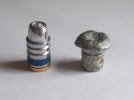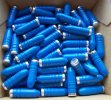Reloader762
Active Member
But those are imposters. That is the NOE version. I bet you prefer the "real" 358156 HP
They are, but they shoot great and expand well, but it's hard to beat the original. The bullet on the right was shot in a 38 snubby at +P velocity with the check left off and just a coat of Alox/JPW lube.

I always check my bullets after coating, I only had a problem getting some of the checks on when I tried to check and size with my Lee push through sizer, so I switched over to the RCBS Lube A Matic to seat checks and size the bullets. Also, using a good powder that just put a fine coat on the bullet using shake and bake instead of spraying the powder on so as not to get excess powder around the gas check shank took care of most of those issues as well.
Here are the Lee 185 gr. bullets sized with the checks installed.

Last edited:
